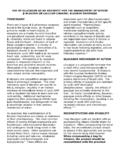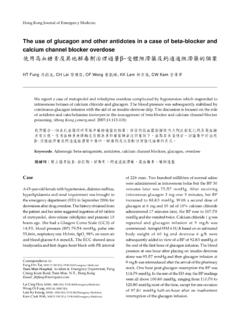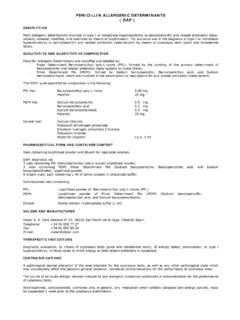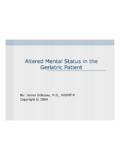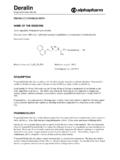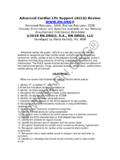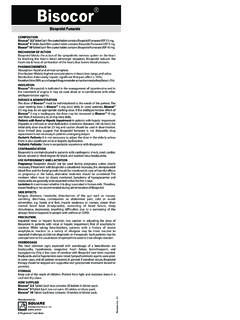Transcription of ToxTidbits: Antidote Facts - Maryland Poison Center
1 toxtidbits : Antidote Facts 1-800-222-1222. Glucagon Beta blockers and calcium channel blockers are commonly used in the treatment of cardiovascular diseases. Though they are two separate classes of drugs, both beta blocker and calcium channel blocker poisonings present with hypotension, bradycardia, heart block, and myocardial depression. Furthermore, noncardiovascular manifestations of toxicity may include change of mental status, seizures, hyperglycemia (with calcium channel blockers) or hypoglycemia (with beta blockers), and respiratory depression. Mechanism/Indications: Beta blocker and calcium channel blocker poisoning can be treated with glucagon, an Antidote and also a regulatory hormone that stimulates glucose release. Glucagon has positive inotropic and chronotropic effects on the myocardium by increasing cAMP.
2 Concentration through a non-adrenergic mechanism. Case studies have shown that it reverses hypotension, bradycardia, and myocardial depression in patients previously showing signs of toxicity. Glucagon, however, cannot reverse conduction disturbances ( prolongation of QRS. interval) caused by some beta blockers with membrane stabilizing activity ( propranolol). Dosing: Glucagon has a fast onset of action and short duration of effect. When given intravenously, its impact on the myocardium is seen within 1 to 3 minutes and lasts for 10 to 15. minutes. The Maryland Poison Center recommends an IV bolus of 5-10 mg (adult) or 50 mcg/kg (pediatric) over 1-5 minutes, followed by a continuous infusion of response dose per hour. Heart rate, blood pressure, ECG, blood glucose, as well as mental status would be useful to monitor the patient's progress and efficacy of the Antidote .
3 Adverse Effects/Contraindications: Adverse effects are primarily nausea and vomiting (up to 30% of patients), which can be minimized by giving lower doses, infusing it at a slower rate, and administering antiemetics. Other adverse effects include hyperglycemia and hypokalemia. Contraindications for glucagon include insulinoma, pheochromocytoma and hypersensitivity to any component of the product. Availability of glucagon is a common issue since many hospitals do not have an adequate supply to provide resuscitation. Therefore, it is essential that hospitals have enough glucagon available to treat overdose patients when needed. Since high doses of glucagon are often required for treatment, we recommend hospitals to maintain a minimum of 50 mg of glucagon in stock.
4 Chi Tran Student Pharmacist University of Maryland School of Pharmacy For more on glucagon: Kerns II W. Management of B-Adrenergic Blocker and Calcium Channel Antagonist Toxicity. Emerg Med Clin N Am. 2007; 25:309-331. Shepherd, G. Treatment of poisoning caused by -adrenergic and calcium-channel blockers. Am J. Health-Syst Pharm. 2006; 63:1828-1835. Howland MA. Antidotes in Depth: Glucagon. In: Flomenbaum NE, Goldfrank LR, Hoffman RS et al, eds: Goldfrank's Toxicologic Emergencies. New York NY, 2006;942-945. February 2010 (reviewed January 2013).
